Organisational Behaviour Report: AM (HOLDINGS) LTD Analysis
VerifiedAdded on 2020/12/29
|12
|4823
|40
Report
AI Summary
This report delves into the core concepts of organisational behaviour, examining how culture, power dynamics, and motivational theories influence individual and team performance within an organisation, using AM (HOLDINGS) LTD. as a case study. It analyses various aspects of organisational culture, including Handy’s Typology and the impact of power structures, and evaluates the effectiveness of different motivational theories, such as content and process theories, in driving employee engagement. The report also differentiates between effective and ineffective teams, highlighting the factors that contribute to team success. Furthermore, it explores the positive and negative aspects of different organisational behaviour philosophies and their impact on employee behaviour, offering insights into how AM (HOLDINGS) LTD. can improve its organisational structure and employee relations. The report concludes by emphasizing the importance of these elements in achieving organisational goals.
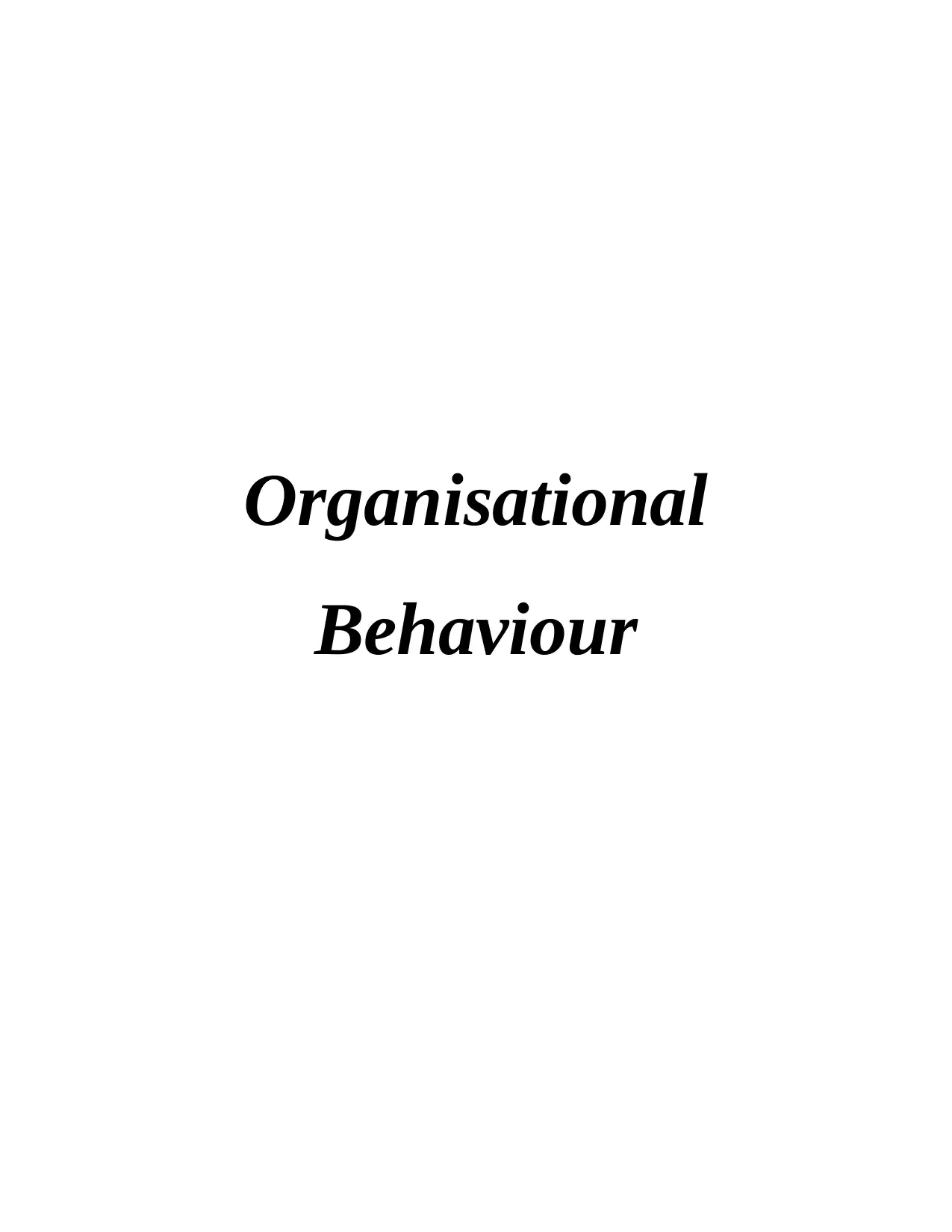
Organisational
Behaviour
Behaviour
Paraphrase This Document
Need a fresh take? Get an instant paraphrase of this document with our AI Paraphraser
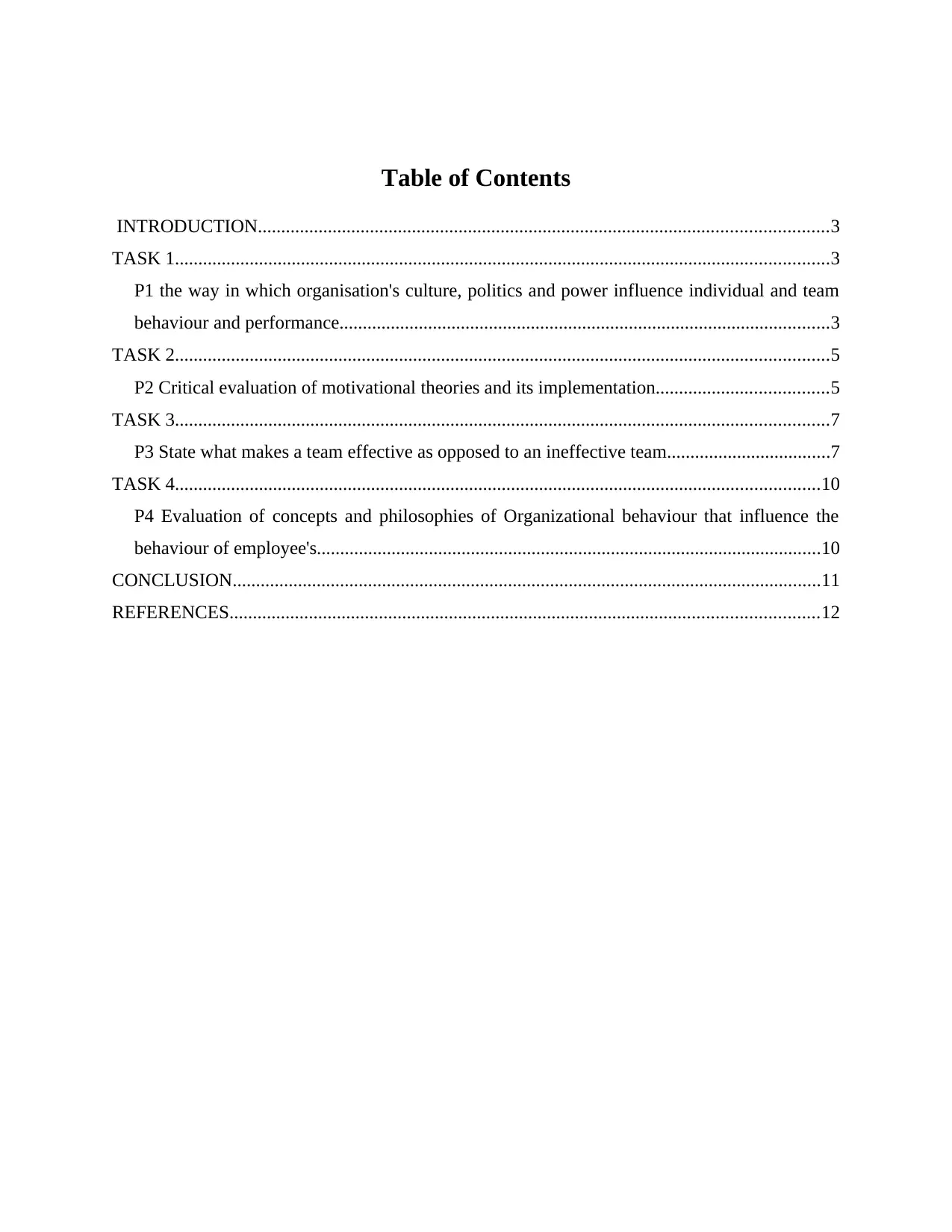
Table of Contents
INTRODUCTION..........................................................................................................................3
TASK 1............................................................................................................................................3
P1 the way in which organisation's culture, politics and power influence individual and team
behaviour and performance.........................................................................................................3
TASK 2............................................................................................................................................5
P2 Critical evaluation of motivational theories and its implementation.....................................5
TASK 3............................................................................................................................................7
P3 State what makes a team effective as opposed to an ineffective team...................................7
TASK 4..........................................................................................................................................10
P4 Evaluation of concepts and philosophies of Organizational behaviour that influence the
behaviour of employee's............................................................................................................10
CONCLUSION..............................................................................................................................11
REFERENCES..............................................................................................................................12
INTRODUCTION..........................................................................................................................3
TASK 1............................................................................................................................................3
P1 the way in which organisation's culture, politics and power influence individual and team
behaviour and performance.........................................................................................................3
TASK 2............................................................................................................................................5
P2 Critical evaluation of motivational theories and its implementation.....................................5
TASK 3............................................................................................................................................7
P3 State what makes a team effective as opposed to an ineffective team...................................7
TASK 4..........................................................................................................................................10
P4 Evaluation of concepts and philosophies of Organizational behaviour that influence the
behaviour of employee's............................................................................................................10
CONCLUSION..............................................................................................................................11
REFERENCES..............................................................................................................................12
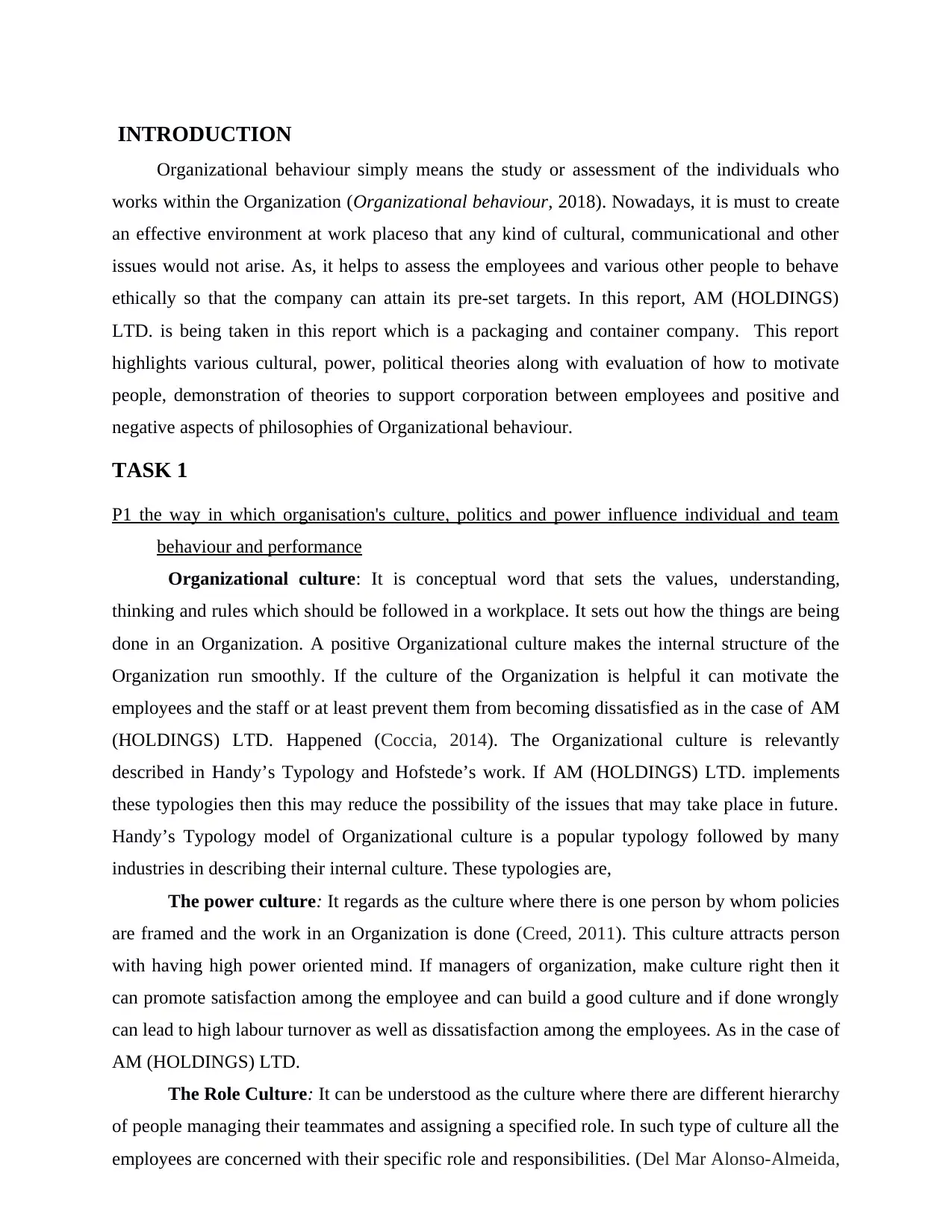
INTRODUCTION
Organizational behaviour simply means the study or assessment of the individuals who
works within the Organization (Organizational behaviour, 2018). Nowadays, it is must to create
an effective environment at work placeso that any kind of cultural, communicational and other
issues would not arise. As, it helps to assess the employees and various other people to behave
ethically so that the company can attain its pre-set targets. In this report, AM (HOLDINGS)
LTD. is being taken in this report which is a packaging and container company. This report
highlights various cultural, power, political theories along with evaluation of how to motivate
people, demonstration of theories to support corporation between employees and positive and
negative aspects of philosophies of Organizational behaviour.
TASK 1
P1 the way in which organisation's culture, politics and power influence individual and team
behaviour and performance
Organizational culture: It is conceptual word that sets the values, understanding,
thinking and rules which should be followed in a workplace. It sets out how the things are being
done in an Organization. A positive Organizational culture makes the internal structure of the
Organization run smoothly. If the culture of the Organization is helpful it can motivate the
employees and the staff or at least prevent them from becoming dissatisfied as in the case of AM
(HOLDINGS) LTD. Happened (Coccia, 2014). The Organizational culture is relevantly
described in Handy’s Typology and Hofstede’s work. If AM (HOLDINGS) LTD. implements
these typologies then this may reduce the possibility of the issues that may take place in future.
Handy’s Typology model of Organizational culture is a popular typology followed by many
industries in describing their internal culture. These typologies are,
The power culture: It regards as the culture where there is one person by whom policies
are framed and the work in an Organization is done (Creed, 2011). This culture attracts person
with having high power oriented mind. If managers of organization, make culture right then it
can promote satisfaction among the employee and can build a good culture and if done wrongly
can lead to high labour turnover as well as dissatisfaction among the employees. As in the case of
AM (HOLDINGS) LTD.
The Role Culture: It can be understood as the culture where there are different hierarchy
of people managing their teammates and assigning a specified role. In such type of culture all the
employees are concerned with their specific role and responsibilities. (Del Mar Alonso-Almeida,
Organizational behaviour simply means the study or assessment of the individuals who
works within the Organization (Organizational behaviour, 2018). Nowadays, it is must to create
an effective environment at work placeso that any kind of cultural, communicational and other
issues would not arise. As, it helps to assess the employees and various other people to behave
ethically so that the company can attain its pre-set targets. In this report, AM (HOLDINGS)
LTD. is being taken in this report which is a packaging and container company. This report
highlights various cultural, power, political theories along with evaluation of how to motivate
people, demonstration of theories to support corporation between employees and positive and
negative aspects of philosophies of Organizational behaviour.
TASK 1
P1 the way in which organisation's culture, politics and power influence individual and team
behaviour and performance
Organizational culture: It is conceptual word that sets the values, understanding,
thinking and rules which should be followed in a workplace. It sets out how the things are being
done in an Organization. A positive Organizational culture makes the internal structure of the
Organization run smoothly. If the culture of the Organization is helpful it can motivate the
employees and the staff or at least prevent them from becoming dissatisfied as in the case of AM
(HOLDINGS) LTD. Happened (Coccia, 2014). The Organizational culture is relevantly
described in Handy’s Typology and Hofstede’s work. If AM (HOLDINGS) LTD. implements
these typologies then this may reduce the possibility of the issues that may take place in future.
Handy’s Typology model of Organizational culture is a popular typology followed by many
industries in describing their internal culture. These typologies are,
The power culture: It regards as the culture where there is one person by whom policies
are framed and the work in an Organization is done (Creed, 2011). This culture attracts person
with having high power oriented mind. If managers of organization, make culture right then it
can promote satisfaction among the employee and can build a good culture and if done wrongly
can lead to high labour turnover as well as dissatisfaction among the employees. As in the case of
AM (HOLDINGS) LTD.
The Role Culture: It can be understood as the culture where there are different hierarchy
of people managing their teammates and assigning a specified role. In such type of culture all the
employees are concerned with their specific role and responsibilities. (Del Mar Alonso-Almeida,
⊘ This is a preview!⊘
Do you want full access?
Subscribe today to unlock all pages.

Trusted by 1+ million students worldwide
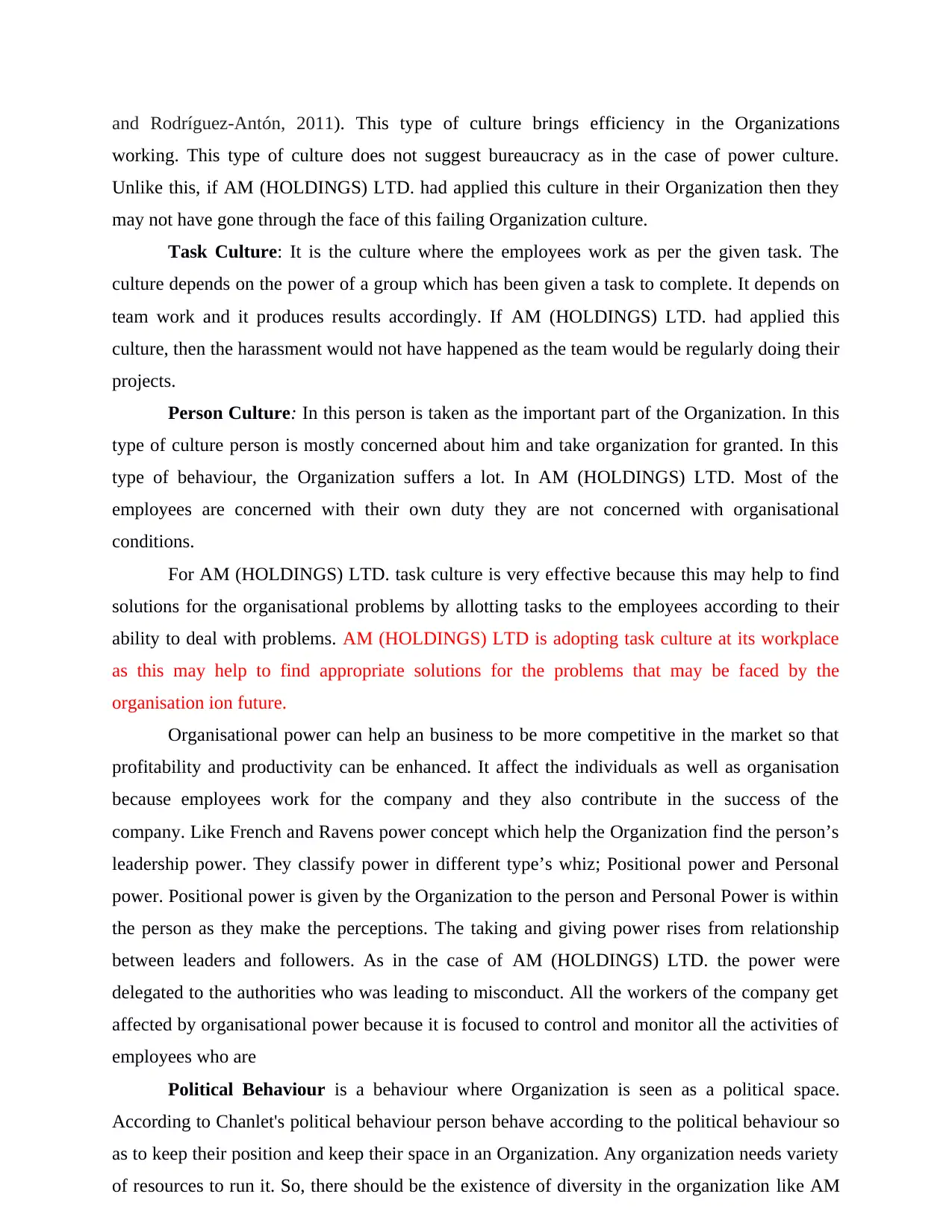
and Rodríguez-Antón, 2011). This type of culture brings efficiency in the Organizations
working. This type of culture does not suggest bureaucracy as in the case of power culture.
Unlike this, if AM (HOLDINGS) LTD. had applied this culture in their Organization then they
may not have gone through the face of this failing Organization culture.
Task Culture: It is the culture where the employees work as per the given task. The
culture depends on the power of a group which has been given a task to complete. It depends on
team work and it produces results accordingly. If AM (HOLDINGS) LTD. had applied this
culture, then the harassment would not have happened as the team would be regularly doing their
projects.
Person Culture: In this person is taken as the important part of the Organization. In this
type of culture person is mostly concerned about him and take organization for granted. In this
type of behaviour, the Organization suffers a lot. In AM (HOLDINGS) LTD. Most of the
employees are concerned with their own duty they are not concerned with organisational
conditions.
For AM (HOLDINGS) LTD. task culture is very effective because this may help to find
solutions for the organisational problems by allotting tasks to the employees according to their
ability to deal with problems. AM (HOLDINGS) LTD is adopting task culture at its workplace
as this may help to find appropriate solutions for the problems that may be faced by the
organisation ion future.
Organisational power can help an business to be more competitive in the market so that
profitability and productivity can be enhanced. It affect the individuals as well as organisation
because employees work for the company and they also contribute in the success of the
company. Like French and Ravens power concept which help the Organization find the person’s
leadership power. They classify power in different type’s whiz; Positional power and Personal
power. Positional power is given by the Organization to the person and Personal Power is within
the person as they make the perceptions. The taking and giving power rises from relationship
between leaders and followers. As in the case of AM (HOLDINGS) LTD. the power were
delegated to the authorities who was leading to misconduct. All the workers of the company get
affected by organisational power because it is focused to control and monitor all the activities of
employees who are
Political Behaviour is a behaviour where Organization is seen as a political space.
According to Chanlet's political behaviour person behave according to the political behaviour so
as to keep their position and keep their space in an Organization. Any organization needs variety
of resources to run it. So, there should be the existence of diversity in the organization like AM
working. This type of culture does not suggest bureaucracy as in the case of power culture.
Unlike this, if AM (HOLDINGS) LTD. had applied this culture in their Organization then they
may not have gone through the face of this failing Organization culture.
Task Culture: It is the culture where the employees work as per the given task. The
culture depends on the power of a group which has been given a task to complete. It depends on
team work and it produces results accordingly. If AM (HOLDINGS) LTD. had applied this
culture, then the harassment would not have happened as the team would be regularly doing their
projects.
Person Culture: In this person is taken as the important part of the Organization. In this
type of culture person is mostly concerned about him and take organization for granted. In this
type of behaviour, the Organization suffers a lot. In AM (HOLDINGS) LTD. Most of the
employees are concerned with their own duty they are not concerned with organisational
conditions.
For AM (HOLDINGS) LTD. task culture is very effective because this may help to find
solutions for the organisational problems by allotting tasks to the employees according to their
ability to deal with problems. AM (HOLDINGS) LTD is adopting task culture at its workplace
as this may help to find appropriate solutions for the problems that may be faced by the
organisation ion future.
Organisational power can help an business to be more competitive in the market so that
profitability and productivity can be enhanced. It affect the individuals as well as organisation
because employees work for the company and they also contribute in the success of the
company. Like French and Ravens power concept which help the Organization find the person’s
leadership power. They classify power in different type’s whiz; Positional power and Personal
power. Positional power is given by the Organization to the person and Personal Power is within
the person as they make the perceptions. The taking and giving power rises from relationship
between leaders and followers. As in the case of AM (HOLDINGS) LTD. the power were
delegated to the authorities who was leading to misconduct. All the workers of the company get
affected by organisational power because it is focused to control and monitor all the activities of
employees who are
Political Behaviour is a behaviour where Organization is seen as a political space.
According to Chanlet's political behaviour person behave according to the political behaviour so
as to keep their position and keep their space in an Organization. Any organization needs variety
of resources to run it. So, there should be the existence of diversity in the organization like AM
Paraphrase This Document
Need a fresh take? Get an instant paraphrase of this document with our AI Paraphraser
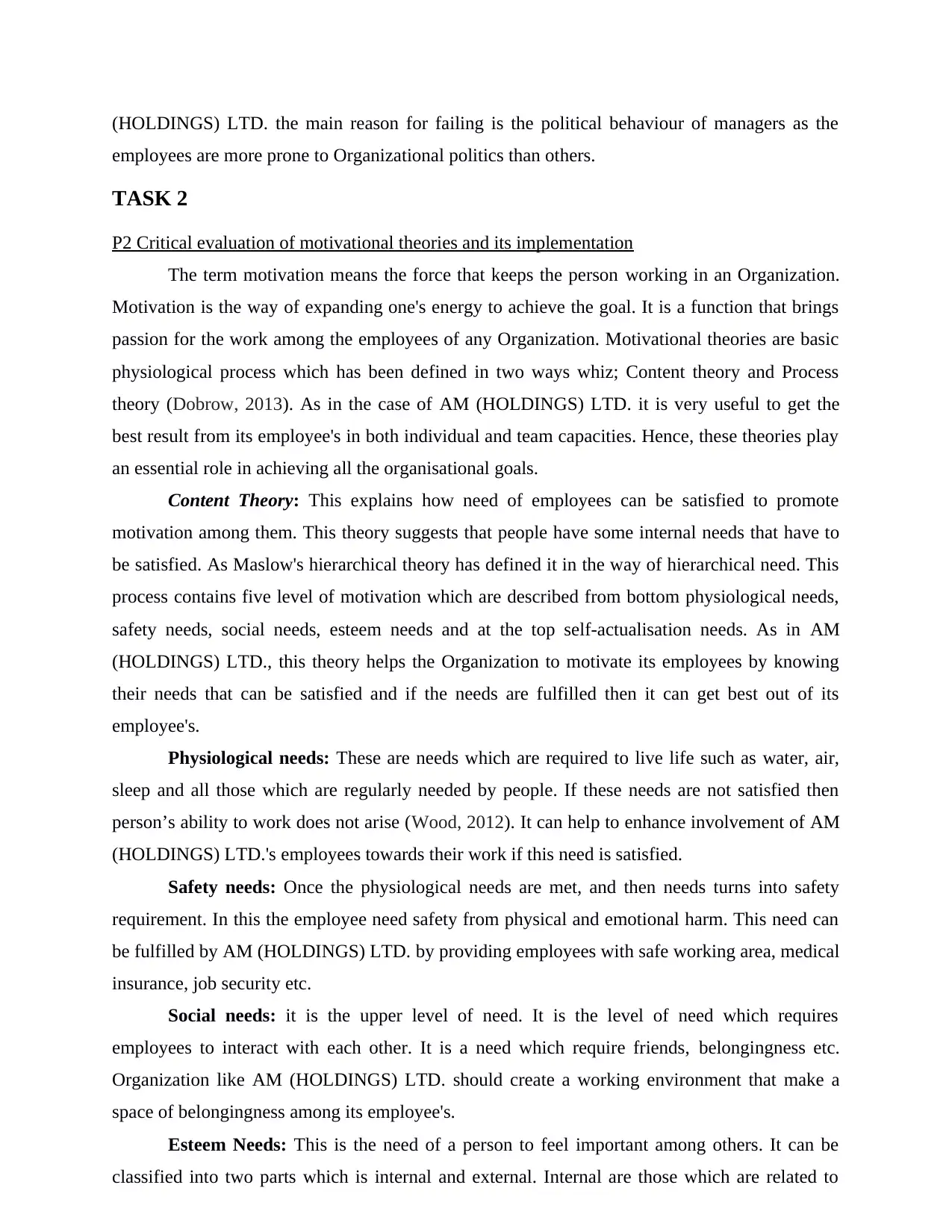
(HOLDINGS) LTD. the main reason for failing is the political behaviour of managers as the
employees are more prone to Organizational politics than others.
TASK 2
P2 Critical evaluation of motivational theories and its implementation
The term motivation means the force that keeps the person working in an Organization.
Motivation is the way of expanding one's energy to achieve the goal. It is a function that brings
passion for the work among the employees of any Organization. Motivational theories are basic
physiological process which has been defined in two ways whiz; Content theory and Process
theory (Dobrow, 2013). As in the case of AM (HOLDINGS) LTD. it is very useful to get the
best result from its employee's in both individual and team capacities. Hence, these theories play
an essential role in achieving all the organisational goals.
Content Theory: This explains how need of employees can be satisfied to promote
motivation among them. This theory suggests that people have some internal needs that have to
be satisfied. As Maslow's hierarchical theory has defined it in the way of hierarchical need. This
process contains five level of motivation which are described from bottom physiological needs,
safety needs, social needs, esteem needs and at the top self-actualisation needs. As in AM
(HOLDINGS) LTD., this theory helps the Organization to motivate its employees by knowing
their needs that can be satisfied and if the needs are fulfilled then it can get best out of its
employee's.
Physiological needs: These are needs which are required to live life such as water, air,
sleep and all those which are regularly needed by people. If these needs are not satisfied then
person’s ability to work does not arise (Wood, 2012). It can help to enhance involvement of AM
(HOLDINGS) LTD.'s employees towards their work if this need is satisfied.
Safety needs: Once the physiological needs are met, and then needs turns into safety
requirement. In this the employee need safety from physical and emotional harm. This need can
be fulfilled by AM (HOLDINGS) LTD. by providing employees with safe working area, medical
insurance, job security etc.
Social needs: it is the upper level of need. It is the level of need which requires
employees to interact with each other. It is a need which require friends, belongingness etc.
Organization like AM (HOLDINGS) LTD. should create a working environment that make a
space of belongingness among its employee's.
Esteem Needs: This is the need of a person to feel important among others. It can be
classified into two parts which is internal and external. Internal are those which are related to
employees are more prone to Organizational politics than others.
TASK 2
P2 Critical evaluation of motivational theories and its implementation
The term motivation means the force that keeps the person working in an Organization.
Motivation is the way of expanding one's energy to achieve the goal. It is a function that brings
passion for the work among the employees of any Organization. Motivational theories are basic
physiological process which has been defined in two ways whiz; Content theory and Process
theory (Dobrow, 2013). As in the case of AM (HOLDINGS) LTD. it is very useful to get the
best result from its employee's in both individual and team capacities. Hence, these theories play
an essential role in achieving all the organisational goals.
Content Theory: This explains how need of employees can be satisfied to promote
motivation among them. This theory suggests that people have some internal needs that have to
be satisfied. As Maslow's hierarchical theory has defined it in the way of hierarchical need. This
process contains five level of motivation which are described from bottom physiological needs,
safety needs, social needs, esteem needs and at the top self-actualisation needs. As in AM
(HOLDINGS) LTD., this theory helps the Organization to motivate its employees by knowing
their needs that can be satisfied and if the needs are fulfilled then it can get best out of its
employee's.
Physiological needs: These are needs which are required to live life such as water, air,
sleep and all those which are regularly needed by people. If these needs are not satisfied then
person’s ability to work does not arise (Wood, 2012). It can help to enhance involvement of AM
(HOLDINGS) LTD.'s employees towards their work if this need is satisfied.
Safety needs: Once the physiological needs are met, and then needs turns into safety
requirement. In this the employee need safety from physical and emotional harm. This need can
be fulfilled by AM (HOLDINGS) LTD. by providing employees with safe working area, medical
insurance, job security etc.
Social needs: it is the upper level of need. It is the level of need which requires
employees to interact with each other. It is a need which require friends, belongingness etc.
Organization like AM (HOLDINGS) LTD. should create a working environment that make a
space of belongingness among its employee's.
Esteem Needs: This is the need of a person to feel important among others. It can be
classified into two parts which is internal and external. Internal are those which are related to
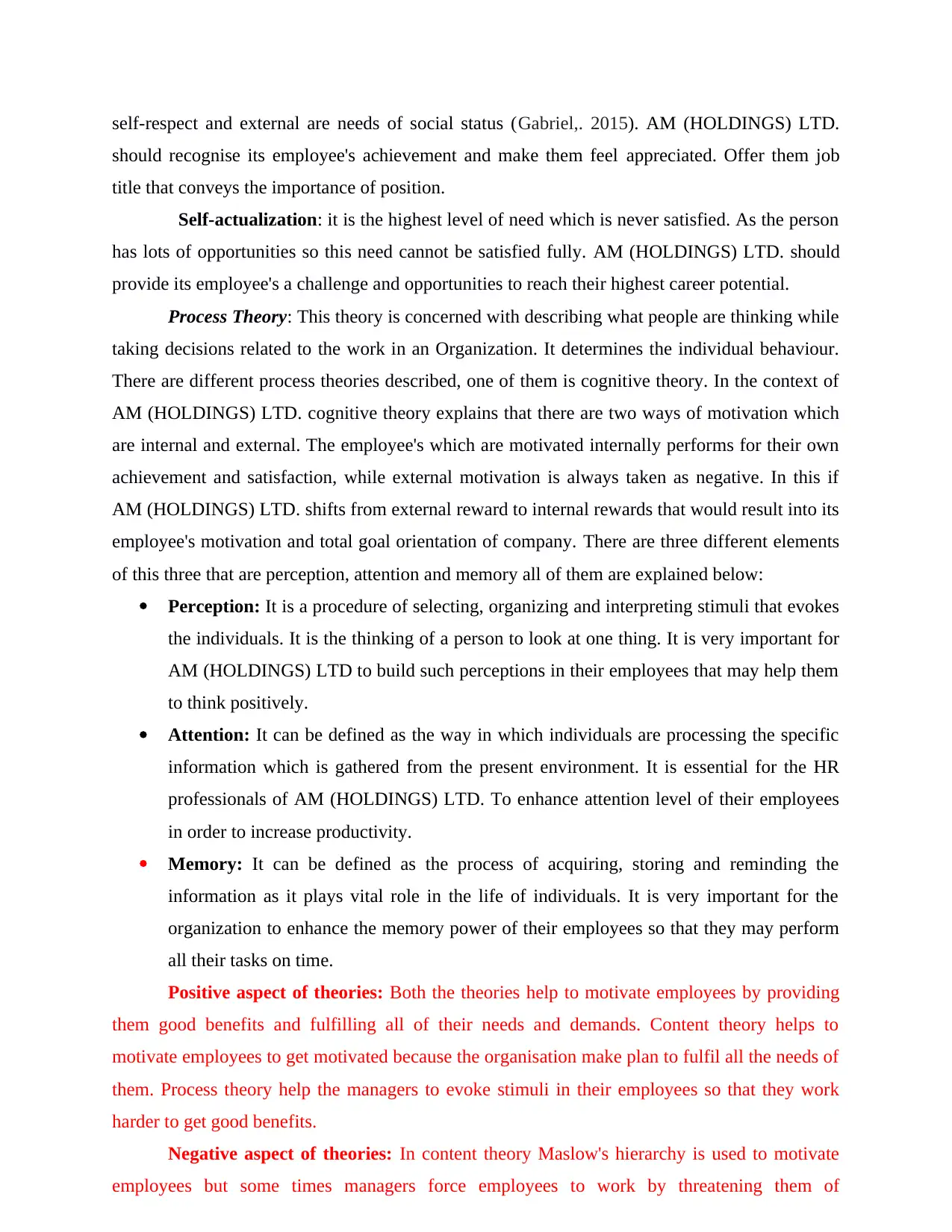
self-respect and external are needs of social status (Gabriel,. 2015). AM (HOLDINGS) LTD.
should recognise its employee's achievement and make them feel appreciated. Offer them job
title that conveys the importance of position.
Self-actualization: it is the highest level of need which is never satisfied. As the person
has lots of opportunities so this need cannot be satisfied fully. AM (HOLDINGS) LTD. should
provide its employee's a challenge and opportunities to reach their highest career potential.
Process Theory: This theory is concerned with describing what people are thinking while
taking decisions related to the work in an Organization. It determines the individual behaviour.
There are different process theories described, one of them is cognitive theory. In the context of
AM (HOLDINGS) LTD. cognitive theory explains that there are two ways of motivation which
are internal and external. The employee's which are motivated internally performs for their own
achievement and satisfaction, while external motivation is always taken as negative. In this if
AM (HOLDINGS) LTD. shifts from external reward to internal rewards that would result into its
employee's motivation and total goal orientation of company. There are three different elements
of this three that are perception, attention and memory all of them are explained below:
Perception: It is a procedure of selecting, organizing and interpreting stimuli that evokes
the individuals. It is the thinking of a person to look at one thing. It is very important for
AM (HOLDINGS) LTD to build such perceptions in their employees that may help them
to think positively.
Attention: It can be defined as the way in which individuals are processing the specific
information which is gathered from the present environment. It is essential for the HR
professionals of AM (HOLDINGS) LTD. To enhance attention level of their employees
in order to increase productivity.
Memory: It can be defined as the process of acquiring, storing and reminding the
information as it plays vital role in the life of individuals. It is very important for the
organization to enhance the memory power of their employees so that they may perform
all their tasks on time.
Positive aspect of theories: Both the theories help to motivate employees by providing
them good benefits and fulfilling all of their needs and demands. Content theory helps to
motivate employees to get motivated because the organisation make plan to fulfil all the needs of
them. Process theory help the managers to evoke stimuli in their employees so that they work
harder to get good benefits.
Negative aspect of theories: In content theory Maslow's hierarchy is used to motivate
employees but some times managers force employees to work by threatening them of
should recognise its employee's achievement and make them feel appreciated. Offer them job
title that conveys the importance of position.
Self-actualization: it is the highest level of need which is never satisfied. As the person
has lots of opportunities so this need cannot be satisfied fully. AM (HOLDINGS) LTD. should
provide its employee's a challenge and opportunities to reach their highest career potential.
Process Theory: This theory is concerned with describing what people are thinking while
taking decisions related to the work in an Organization. It determines the individual behaviour.
There are different process theories described, one of them is cognitive theory. In the context of
AM (HOLDINGS) LTD. cognitive theory explains that there are two ways of motivation which
are internal and external. The employee's which are motivated internally performs for their own
achievement and satisfaction, while external motivation is always taken as negative. In this if
AM (HOLDINGS) LTD. shifts from external reward to internal rewards that would result into its
employee's motivation and total goal orientation of company. There are three different elements
of this three that are perception, attention and memory all of them are explained below:
Perception: It is a procedure of selecting, organizing and interpreting stimuli that evokes
the individuals. It is the thinking of a person to look at one thing. It is very important for
AM (HOLDINGS) LTD to build such perceptions in their employees that may help them
to think positively.
Attention: It can be defined as the way in which individuals are processing the specific
information which is gathered from the present environment. It is essential for the HR
professionals of AM (HOLDINGS) LTD. To enhance attention level of their employees
in order to increase productivity.
Memory: It can be defined as the process of acquiring, storing and reminding the
information as it plays vital role in the life of individuals. It is very important for the
organization to enhance the memory power of their employees so that they may perform
all their tasks on time.
Positive aspect of theories: Both the theories help to motivate employees by providing
them good benefits and fulfilling all of their needs and demands. Content theory helps to
motivate employees to get motivated because the organisation make plan to fulfil all the needs of
them. Process theory help the managers to evoke stimuli in their employees so that they work
harder to get good benefits.
Negative aspect of theories: In content theory Maslow's hierarchy is used to motivate
employees but some times managers force employees to work by threatening them of
⊘ This is a preview!⊘
Do you want full access?
Subscribe today to unlock all pages.

Trusted by 1+ million students worldwide
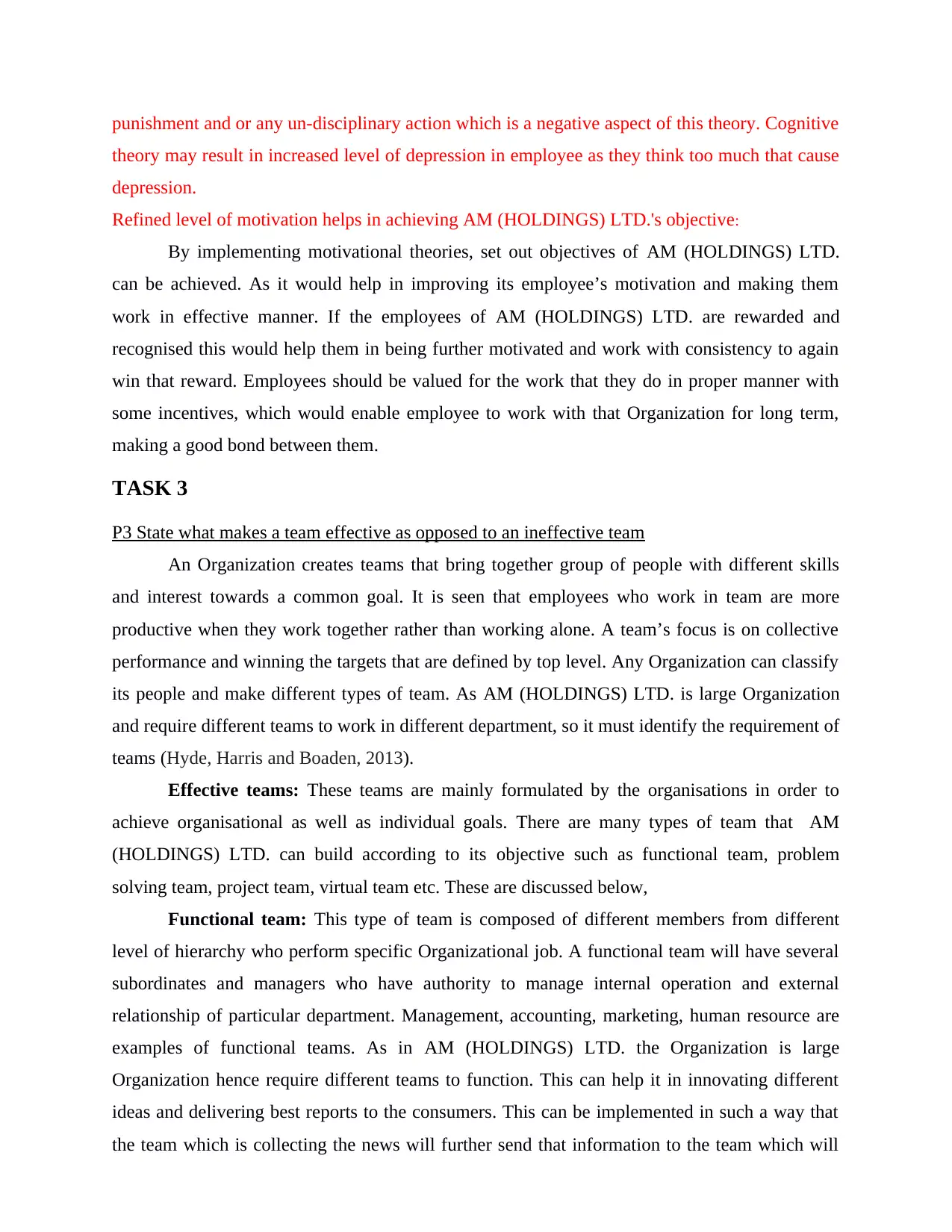
punishment and or any un-disciplinary action which is a negative aspect of this theory. Cognitive
theory may result in increased level of depression in employee as they think too much that cause
depression.
Refined level of motivation helps in achieving AM (HOLDINGS) LTD.'s objective:
By implementing motivational theories, set out objectives of AM (HOLDINGS) LTD.
can be achieved. As it would help in improving its employee’s motivation and making them
work in effective manner. If the employees of AM (HOLDINGS) LTD. are rewarded and
recognised this would help them in being further motivated and work with consistency to again
win that reward. Employees should be valued for the work that they do in proper manner with
some incentives, which would enable employee to work with that Organization for long term,
making a good bond between them.
TASK 3
P3 State what makes a team effective as opposed to an ineffective team
An Organization creates teams that bring together group of people with different skills
and interest towards a common goal. It is seen that employees who work in team are more
productive when they work together rather than working alone. A team’s focus is on collective
performance and winning the targets that are defined by top level. Any Organization can classify
its people and make different types of team. As AM (HOLDINGS) LTD. is large Organization
and require different teams to work in different department, so it must identify the requirement of
teams (Hyde, Harris and Boaden, 2013).
Effective teams: These teams are mainly formulated by the organisations in order to
achieve organisational as well as individual goals. There are many types of team that AM
(HOLDINGS) LTD. can build according to its objective such as functional team, problem
solving team, project team, virtual team etc. These are discussed below,
Functional team: This type of team is composed of different members from different
level of hierarchy who perform specific Organizational job. A functional team will have several
subordinates and managers who have authority to manage internal operation and external
relationship of particular department. Management, accounting, marketing, human resource are
examples of functional teams. As in AM (HOLDINGS) LTD. the Organization is large
Organization hence require different teams to function. This can help it in innovating different
ideas and delivering best reports to the consumers. This can be implemented in such a way that
the team which is collecting the news will further send that information to the team which will
theory may result in increased level of depression in employee as they think too much that cause
depression.
Refined level of motivation helps in achieving AM (HOLDINGS) LTD.'s objective:
By implementing motivational theories, set out objectives of AM (HOLDINGS) LTD.
can be achieved. As it would help in improving its employee’s motivation and making them
work in effective manner. If the employees of AM (HOLDINGS) LTD. are rewarded and
recognised this would help them in being further motivated and work with consistency to again
win that reward. Employees should be valued for the work that they do in proper manner with
some incentives, which would enable employee to work with that Organization for long term,
making a good bond between them.
TASK 3
P3 State what makes a team effective as opposed to an ineffective team
An Organization creates teams that bring together group of people with different skills
and interest towards a common goal. It is seen that employees who work in team are more
productive when they work together rather than working alone. A team’s focus is on collective
performance and winning the targets that are defined by top level. Any Organization can classify
its people and make different types of team. As AM (HOLDINGS) LTD. is large Organization
and require different teams to work in different department, so it must identify the requirement of
teams (Hyde, Harris and Boaden, 2013).
Effective teams: These teams are mainly formulated by the organisations in order to
achieve organisational as well as individual goals. There are many types of team that AM
(HOLDINGS) LTD. can build according to its objective such as functional team, problem
solving team, project team, virtual team etc. These are discussed below,
Functional team: This type of team is composed of different members from different
level of hierarchy who perform specific Organizational job. A functional team will have several
subordinates and managers who have authority to manage internal operation and external
relationship of particular department. Management, accounting, marketing, human resource are
examples of functional teams. As in AM (HOLDINGS) LTD. the Organization is large
Organization hence require different teams to function. This can help it in innovating different
ideas and delivering best reports to the consumers. This can be implemented in such a way that
the team which is collecting the news will further send that information to the team which will
Paraphrase This Document
Need a fresh take? Get an instant paraphrase of this document with our AI Paraphraser
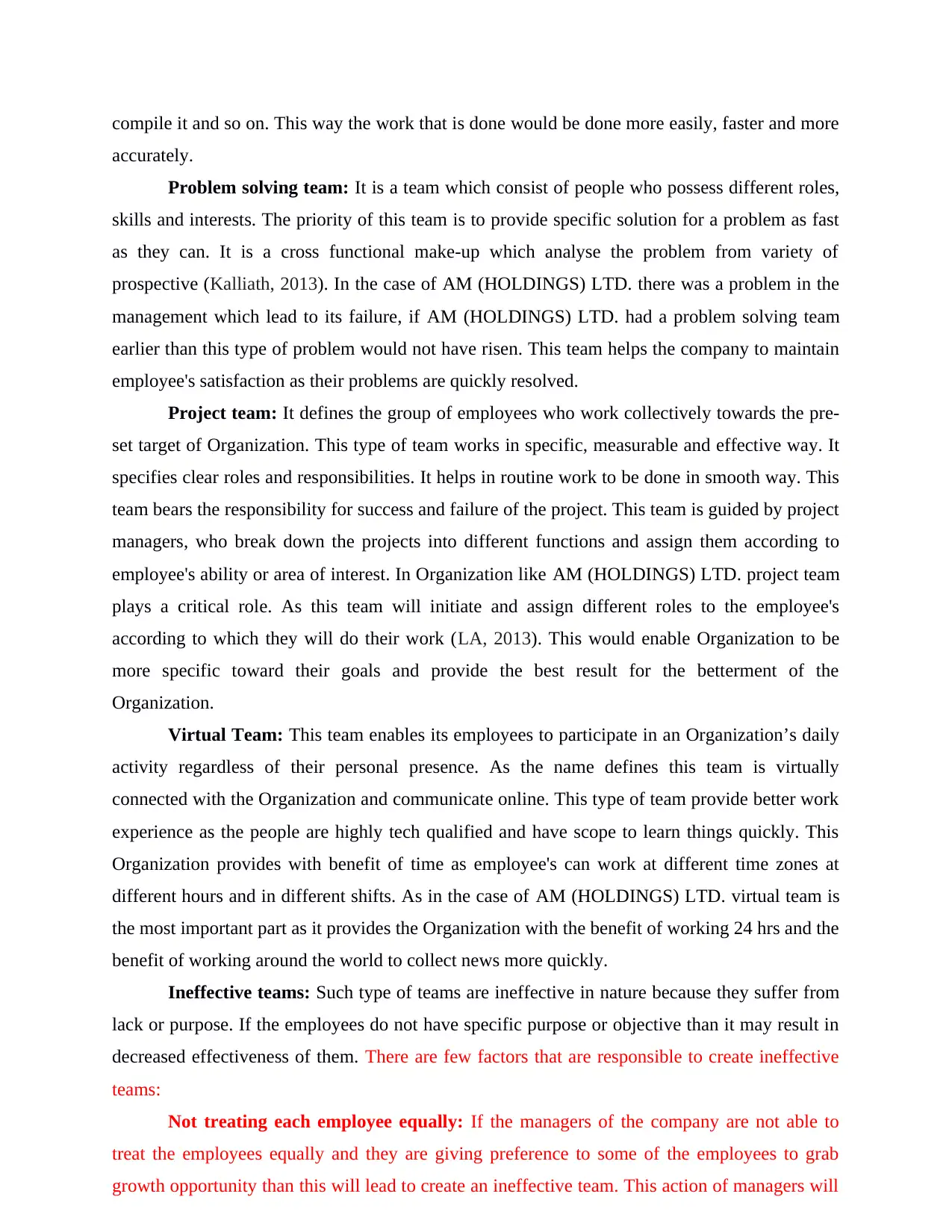
compile it and so on. This way the work that is done would be done more easily, faster and more
accurately.
Problem solving team: It is a team which consist of people who possess different roles,
skills and interests. The priority of this team is to provide specific solution for a problem as fast
as they can. It is a cross functional make-up which analyse the problem from variety of
prospective (Kalliath, 2013). In the case of AM (HOLDINGS) LTD. there was a problem in the
management which lead to its failure, if AM (HOLDINGS) LTD. had a problem solving team
earlier than this type of problem would not have risen. This team helps the company to maintain
employee's satisfaction as their problems are quickly resolved.
Project team: It defines the group of employees who work collectively towards the pre-
set target of Organization. This type of team works in specific, measurable and effective way. It
specifies clear roles and responsibilities. It helps in routine work to be done in smooth way. This
team bears the responsibility for success and failure of the project. This team is guided by project
managers, who break down the projects into different functions and assign them according to
employee's ability or area of interest. In Organization like AM (HOLDINGS) LTD. project team
plays a critical role. As this team will initiate and assign different roles to the employee's
according to which they will do their work (LA, 2013). This would enable Organization to be
more specific toward their goals and provide the best result for the betterment of the
Organization.
Virtual Team: This team enables its employees to participate in an Organization’s daily
activity regardless of their personal presence. As the name defines this team is virtually
connected with the Organization and communicate online. This type of team provide better work
experience as the people are highly tech qualified and have scope to learn things quickly. This
Organization provides with benefit of time as employee's can work at different time zones at
different hours and in different shifts. As in the case of AM (HOLDINGS) LTD. virtual team is
the most important part as it provides the Organization with the benefit of working 24 hrs and the
benefit of working around the world to collect news more quickly.
Ineffective teams: Such type of teams are ineffective in nature because they suffer from
lack or purpose. If the employees do not have specific purpose or objective than it may result in
decreased effectiveness of them. There are few factors that are responsible to create ineffective
teams:
Not treating each employee equally: If the managers of the company are not able to
treat the employees equally and they are giving preference to some of the employees to grab
growth opportunity than this will lead to create an ineffective team. This action of managers will
accurately.
Problem solving team: It is a team which consist of people who possess different roles,
skills and interests. The priority of this team is to provide specific solution for a problem as fast
as they can. It is a cross functional make-up which analyse the problem from variety of
prospective (Kalliath, 2013). In the case of AM (HOLDINGS) LTD. there was a problem in the
management which lead to its failure, if AM (HOLDINGS) LTD. had a problem solving team
earlier than this type of problem would not have risen. This team helps the company to maintain
employee's satisfaction as their problems are quickly resolved.
Project team: It defines the group of employees who work collectively towards the pre-
set target of Organization. This type of team works in specific, measurable and effective way. It
specifies clear roles and responsibilities. It helps in routine work to be done in smooth way. This
team bears the responsibility for success and failure of the project. This team is guided by project
managers, who break down the projects into different functions and assign them according to
employee's ability or area of interest. In Organization like AM (HOLDINGS) LTD. project team
plays a critical role. As this team will initiate and assign different roles to the employee's
according to which they will do their work (LA, 2013). This would enable Organization to be
more specific toward their goals and provide the best result for the betterment of the
Organization.
Virtual Team: This team enables its employees to participate in an Organization’s daily
activity regardless of their personal presence. As the name defines this team is virtually
connected with the Organization and communicate online. This type of team provide better work
experience as the people are highly tech qualified and have scope to learn things quickly. This
Organization provides with benefit of time as employee's can work at different time zones at
different hours and in different shifts. As in the case of AM (HOLDINGS) LTD. virtual team is
the most important part as it provides the Organization with the benefit of working 24 hrs and the
benefit of working around the world to collect news more quickly.
Ineffective teams: Such type of teams are ineffective in nature because they suffer from
lack or purpose. If the employees do not have specific purpose or objective than it may result in
decreased effectiveness of them. There are few factors that are responsible to create ineffective
teams:
Not treating each employee equally: If the managers of the company are not able to
treat the employees equally and they are giving preference to some of the employees to grab
growth opportunity than this will lead to create an ineffective team. This action of managers will
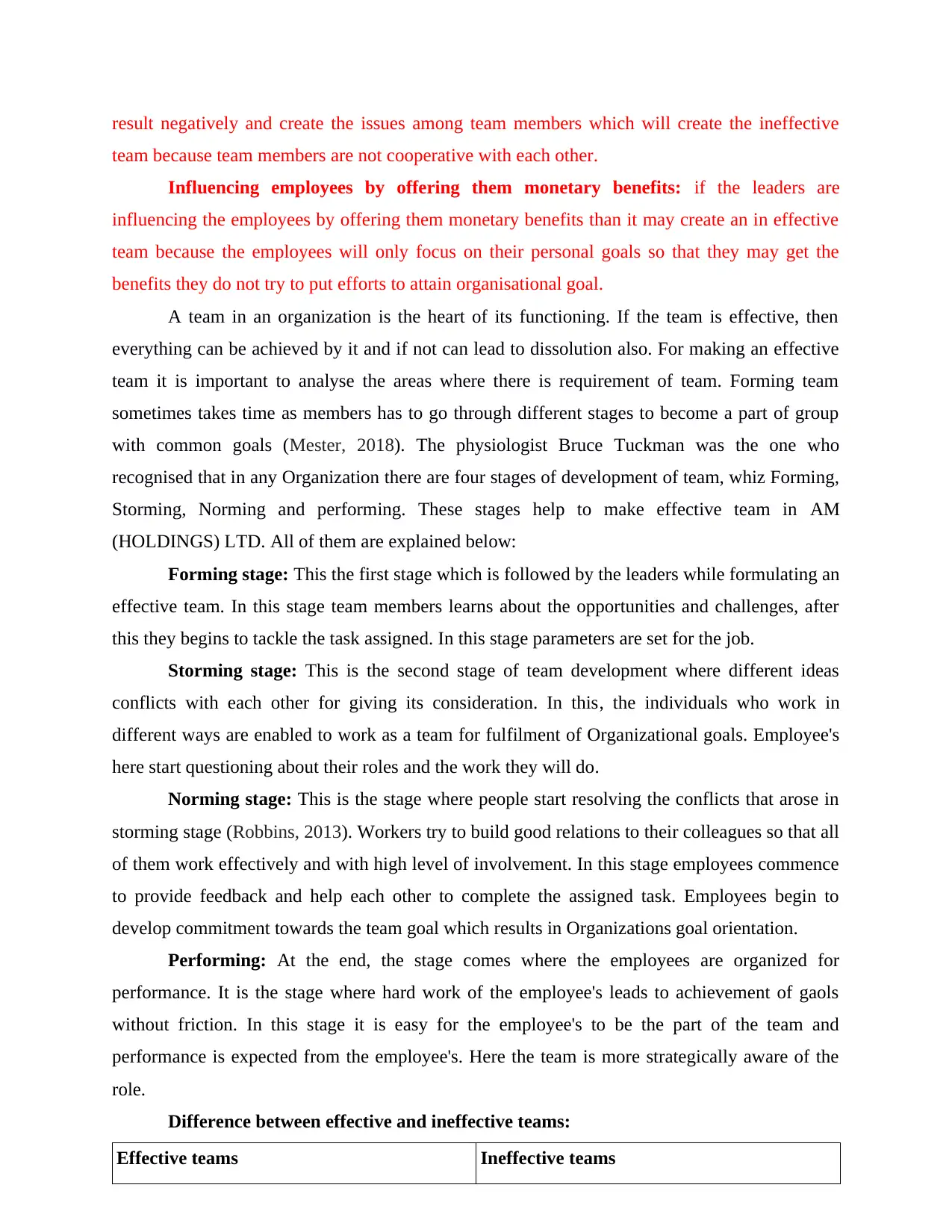
result negatively and create the issues among team members which will create the ineffective
team because team members are not cooperative with each other.
Influencing employees by offering them monetary benefits: if the leaders are
influencing the employees by offering them monetary benefits than it may create an in effective
team because the employees will only focus on their personal goals so that they may get the
benefits they do not try to put efforts to attain organisational goal.
A team in an organization is the heart of its functioning. If the team is effective, then
everything can be achieved by it and if not can lead to dissolution also. For making an effective
team it is important to analyse the areas where there is requirement of team. Forming team
sometimes takes time as members has to go through different stages to become a part of group
with common goals (Mester, 2018). The physiologist Bruce Tuckman was the one who
recognised that in any Organization there are four stages of development of team, whiz Forming,
Storming, Norming and performing. These stages help to make effective team in AM
(HOLDINGS) LTD. All of them are explained below:
Forming stage: This the first stage which is followed by the leaders while formulating an
effective team. In this stage team members learns about the opportunities and challenges, after
this they begins to tackle the task assigned. In this stage parameters are set for the job.
Storming stage: This is the second stage of team development where different ideas
conflicts with each other for giving its consideration. In this, the individuals who work in
different ways are enabled to work as a team for fulfilment of Organizational goals. Employee's
here start questioning about their roles and the work they will do.
Norming stage: This is the stage where people start resolving the conflicts that arose in
storming stage (Robbins, 2013). Workers try to build good relations to their colleagues so that all
of them work effectively and with high level of involvement. In this stage employees commence
to provide feedback and help each other to complete the assigned task. Employees begin to
develop commitment towards the team goal which results in Organizations goal orientation.
Performing: At the end, the stage comes where the employees are organized for
performance. It is the stage where hard work of the employee's leads to achievement of gaols
without friction. In this stage it is easy for the employee's to be the part of the team and
performance is expected from the employee's. Here the team is more strategically aware of the
role.
Difference between effective and ineffective teams:
Effective teams Ineffective teams
team because team members are not cooperative with each other.
Influencing employees by offering them monetary benefits: if the leaders are
influencing the employees by offering them monetary benefits than it may create an in effective
team because the employees will only focus on their personal goals so that they may get the
benefits they do not try to put efforts to attain organisational goal.
A team in an organization is the heart of its functioning. If the team is effective, then
everything can be achieved by it and if not can lead to dissolution also. For making an effective
team it is important to analyse the areas where there is requirement of team. Forming team
sometimes takes time as members has to go through different stages to become a part of group
with common goals (Mester, 2018). The physiologist Bruce Tuckman was the one who
recognised that in any Organization there are four stages of development of team, whiz Forming,
Storming, Norming and performing. These stages help to make effective team in AM
(HOLDINGS) LTD. All of them are explained below:
Forming stage: This the first stage which is followed by the leaders while formulating an
effective team. In this stage team members learns about the opportunities and challenges, after
this they begins to tackle the task assigned. In this stage parameters are set for the job.
Storming stage: This is the second stage of team development where different ideas
conflicts with each other for giving its consideration. In this, the individuals who work in
different ways are enabled to work as a team for fulfilment of Organizational goals. Employee's
here start questioning about their roles and the work they will do.
Norming stage: This is the stage where people start resolving the conflicts that arose in
storming stage (Robbins, 2013). Workers try to build good relations to their colleagues so that all
of them work effectively and with high level of involvement. In this stage employees commence
to provide feedback and help each other to complete the assigned task. Employees begin to
develop commitment towards the team goal which results in Organizations goal orientation.
Performing: At the end, the stage comes where the employees are organized for
performance. It is the stage where hard work of the employee's leads to achievement of gaols
without friction. In this stage it is easy for the employee's to be the part of the team and
performance is expected from the employee's. Here the team is more strategically aware of the
role.
Difference between effective and ineffective teams:
Effective teams Ineffective teams
⊘ This is a preview!⊘
Do you want full access?
Subscribe today to unlock all pages.

Trusted by 1+ million students worldwide
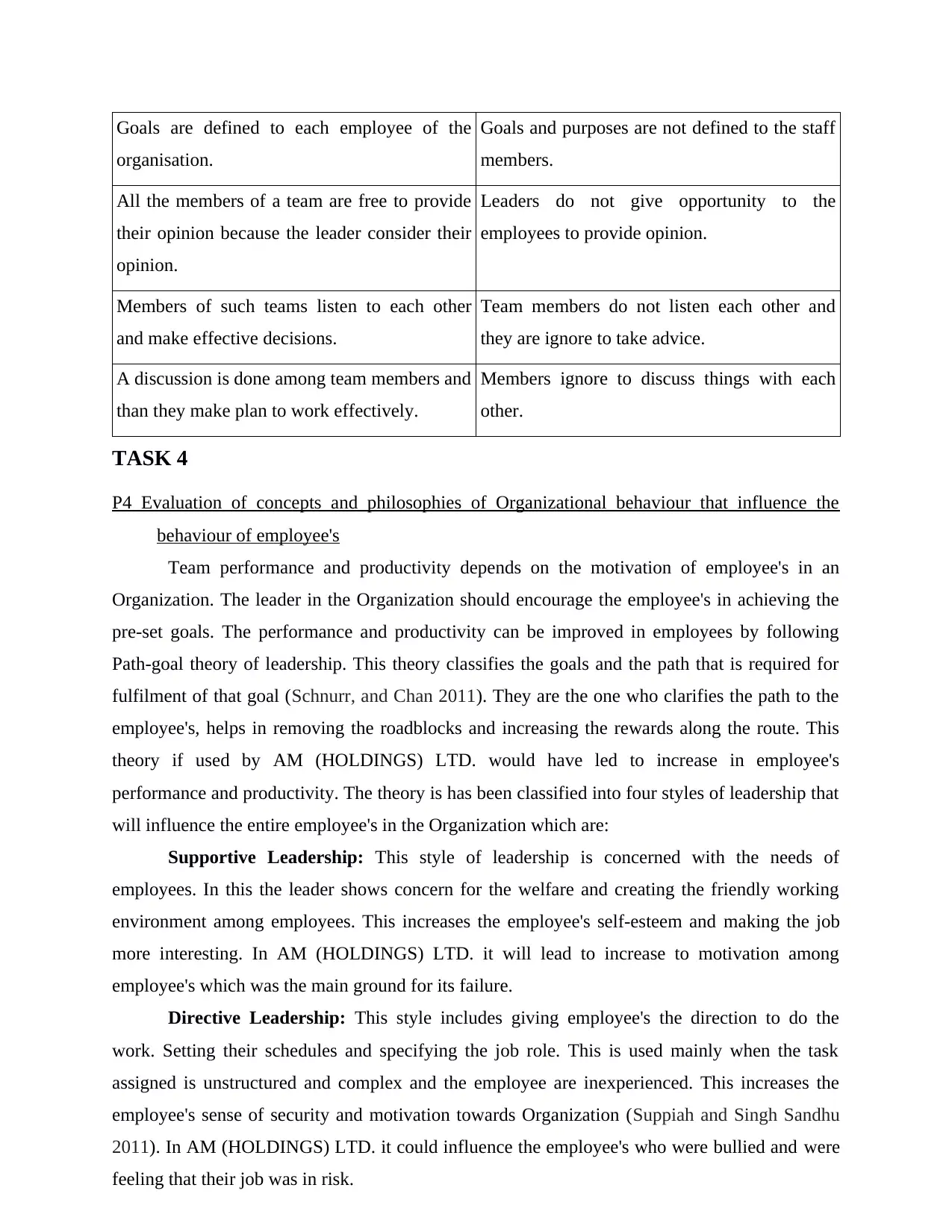
Goals are defined to each employee of the
organisation.
Goals and purposes are not defined to the staff
members.
All the members of a team are free to provide
their opinion because the leader consider their
opinion.
Leaders do not give opportunity to the
employees to provide opinion.
Members of such teams listen to each other
and make effective decisions.
Team members do not listen each other and
they are ignore to take advice.
A discussion is done among team members and
than they make plan to work effectively.
Members ignore to discuss things with each
other.
TASK 4
P4 Evaluation of concepts and philosophies of Organizational behaviour that influence the
behaviour of employee's
Team performance and productivity depends on the motivation of employee's in an
Organization. The leader in the Organization should encourage the employee's in achieving the
pre-set goals. The performance and productivity can be improved in employees by following
Path-goal theory of leadership. This theory classifies the goals and the path that is required for
fulfilment of that goal (Schnurr, and Chan 2011). They are the one who clarifies the path to the
employee's, helps in removing the roadblocks and increasing the rewards along the route. This
theory if used by AM (HOLDINGS) LTD. would have led to increase in employee's
performance and productivity. The theory is has been classified into four styles of leadership that
will influence the entire employee's in the Organization which are:
Supportive Leadership: This style of leadership is concerned with the needs of
employees. In this the leader shows concern for the welfare and creating the friendly working
environment among employees. This increases the employee's self-esteem and making the job
more interesting. In AM (HOLDINGS) LTD. it will lead to increase to motivation among
employee's which was the main ground for its failure.
Directive Leadership: This style includes giving employee's the direction to do the
work. Setting their schedules and specifying the job role. This is used mainly when the task
assigned is unstructured and complex and the employee are inexperienced. This increases the
employee's sense of security and motivation towards Organization (Suppiah and Singh Sandhu
2011). In AM (HOLDINGS) LTD. it could influence the employee's who were bullied and were
feeling that their job was in risk.
organisation.
Goals and purposes are not defined to the staff
members.
All the members of a team are free to provide
their opinion because the leader consider their
opinion.
Leaders do not give opportunity to the
employees to provide opinion.
Members of such teams listen to each other
and make effective decisions.
Team members do not listen each other and
they are ignore to take advice.
A discussion is done among team members and
than they make plan to work effectively.
Members ignore to discuss things with each
other.
TASK 4
P4 Evaluation of concepts and philosophies of Organizational behaviour that influence the
behaviour of employee's
Team performance and productivity depends on the motivation of employee's in an
Organization. The leader in the Organization should encourage the employee's in achieving the
pre-set goals. The performance and productivity can be improved in employees by following
Path-goal theory of leadership. This theory classifies the goals and the path that is required for
fulfilment of that goal (Schnurr, and Chan 2011). They are the one who clarifies the path to the
employee's, helps in removing the roadblocks and increasing the rewards along the route. This
theory if used by AM (HOLDINGS) LTD. would have led to increase in employee's
performance and productivity. The theory is has been classified into four styles of leadership that
will influence the entire employee's in the Organization which are:
Supportive Leadership: This style of leadership is concerned with the needs of
employees. In this the leader shows concern for the welfare and creating the friendly working
environment among employees. This increases the employee's self-esteem and making the job
more interesting. In AM (HOLDINGS) LTD. it will lead to increase to motivation among
employee's which was the main ground for its failure.
Directive Leadership: This style includes giving employee's the direction to do the
work. Setting their schedules and specifying the job role. This is used mainly when the task
assigned is unstructured and complex and the employee are inexperienced. This increases the
employee's sense of security and motivation towards Organization (Suppiah and Singh Sandhu
2011). In AM (HOLDINGS) LTD. it could influence the employee's who were bullied and were
feeling that their job was in risk.
Paraphrase This Document
Need a fresh take? Get an instant paraphrase of this document with our AI Paraphraser
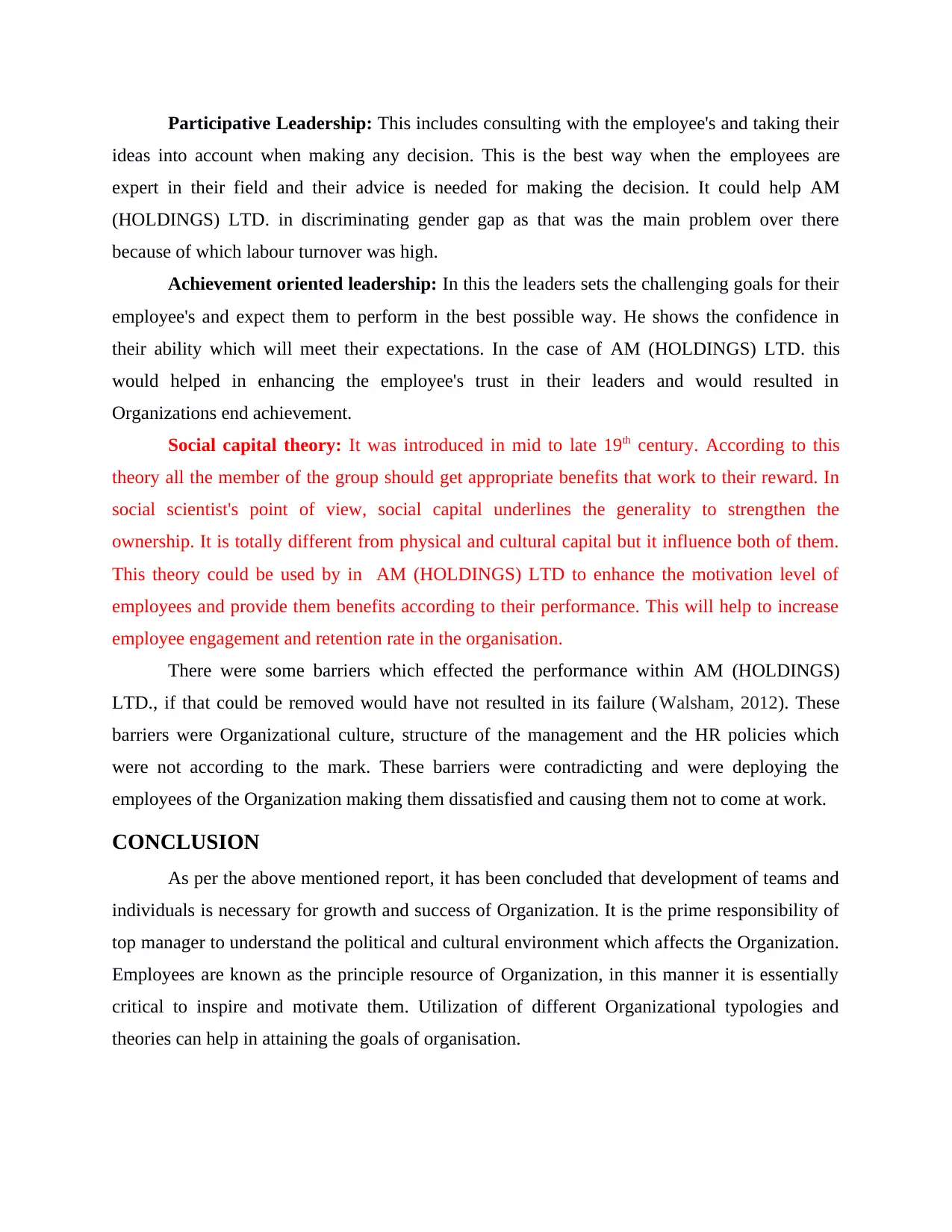
Participative Leadership: This includes consulting with the employee's and taking their
ideas into account when making any decision. This is the best way when the employees are
expert in their field and their advice is needed for making the decision. It could help AM
(HOLDINGS) LTD. in discriminating gender gap as that was the main problem over there
because of which labour turnover was high.
Achievement oriented leadership: In this the leaders sets the challenging goals for their
employee's and expect them to perform in the best possible way. He shows the confidence in
their ability which will meet their expectations. In the case of AM (HOLDINGS) LTD. this
would helped in enhancing the employee's trust in their leaders and would resulted in
Organizations end achievement.
Social capital theory: It was introduced in mid to late 19th century. According to this
theory all the member of the group should get appropriate benefits that work to their reward. In
social scientist's point of view, social capital underlines the generality to strengthen the
ownership. It is totally different from physical and cultural capital but it influence both of them.
This theory could be used by in AM (HOLDINGS) LTD to enhance the motivation level of
employees and provide them benefits according to their performance. This will help to increase
employee engagement and retention rate in the organisation.
There were some barriers which effected the performance within AM (HOLDINGS)
LTD., if that could be removed would have not resulted in its failure (Walsham, 2012). These
barriers were Organizational culture, structure of the management and the HR policies which
were not according to the mark. These barriers were contradicting and were deploying the
employees of the Organization making them dissatisfied and causing them not to come at work.
CONCLUSION
As per the above mentioned report, it has been concluded that development of teams and
individuals is necessary for growth and success of Organization. It is the prime responsibility of
top manager to understand the political and cultural environment which affects the Organization.
Employees are known as the principle resource of Organization, in this manner it is essentially
critical to inspire and motivate them. Utilization of different Organizational typologies and
theories can help in attaining the goals of organisation.
ideas into account when making any decision. This is the best way when the employees are
expert in their field and their advice is needed for making the decision. It could help AM
(HOLDINGS) LTD. in discriminating gender gap as that was the main problem over there
because of which labour turnover was high.
Achievement oriented leadership: In this the leaders sets the challenging goals for their
employee's and expect them to perform in the best possible way. He shows the confidence in
their ability which will meet their expectations. In the case of AM (HOLDINGS) LTD. this
would helped in enhancing the employee's trust in their leaders and would resulted in
Organizations end achievement.
Social capital theory: It was introduced in mid to late 19th century. According to this
theory all the member of the group should get appropriate benefits that work to their reward. In
social scientist's point of view, social capital underlines the generality to strengthen the
ownership. It is totally different from physical and cultural capital but it influence both of them.
This theory could be used by in AM (HOLDINGS) LTD to enhance the motivation level of
employees and provide them benefits according to their performance. This will help to increase
employee engagement and retention rate in the organisation.
There were some barriers which effected the performance within AM (HOLDINGS)
LTD., if that could be removed would have not resulted in its failure (Walsham, 2012). These
barriers were Organizational culture, structure of the management and the HR policies which
were not according to the mark. These barriers were contradicting and were deploying the
employees of the Organization making them dissatisfied and causing them not to come at work.
CONCLUSION
As per the above mentioned report, it has been concluded that development of teams and
individuals is necessary for growth and success of Organization. It is the prime responsibility of
top manager to understand the political and cultural environment which affects the Organization.
Employees are known as the principle resource of Organization, in this manner it is essentially
critical to inspire and motivate them. Utilization of different Organizational typologies and
theories can help in attaining the goals of organisation.
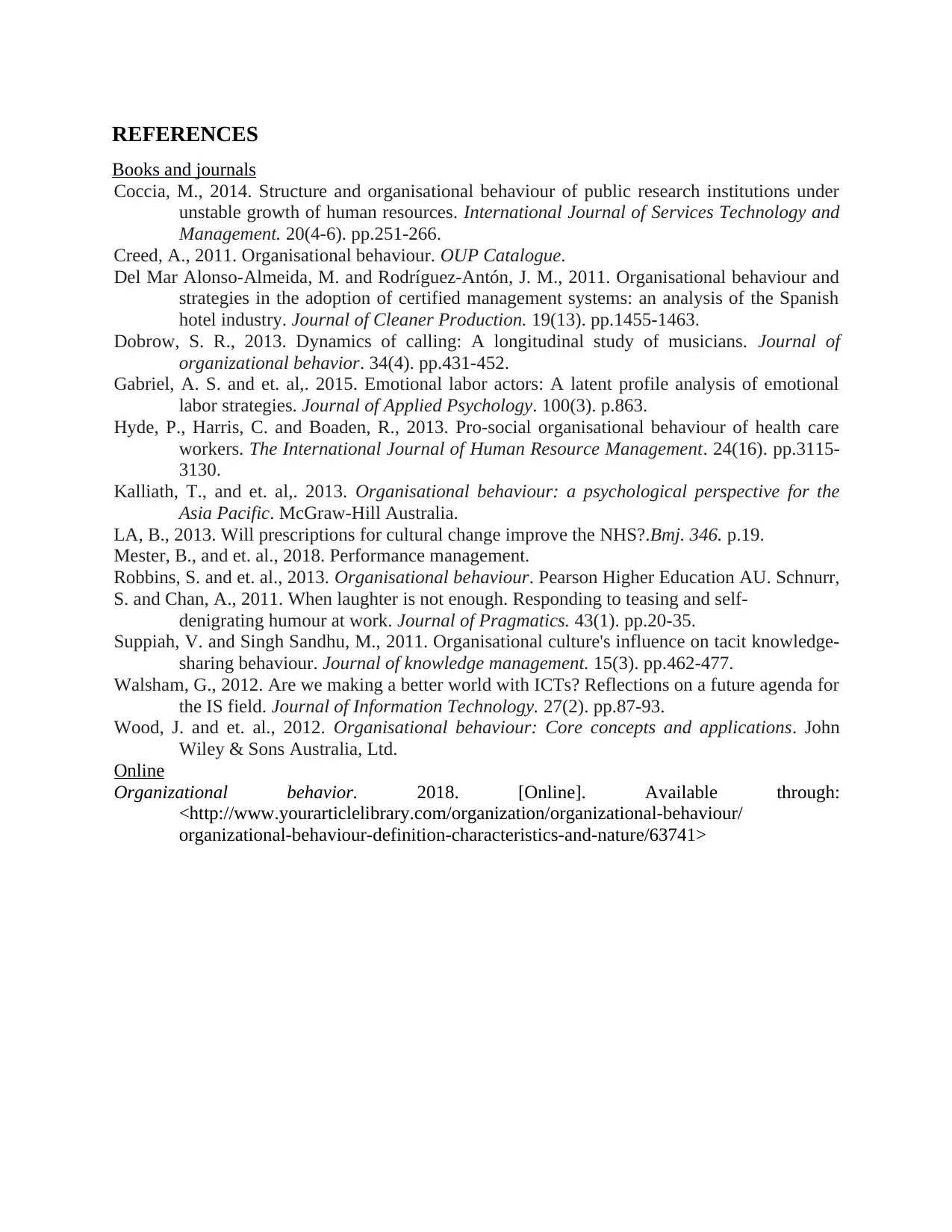
REFERENCES
Books and journals
Coccia, M., 2014. Structure and organisational behaviour of public research institutions under
unstable growth of human resources. International Journal of Services Technology and
Management. 20(4-6). pp.251-266.
Creed, A., 2011. Organisational behaviour. OUP Catalogue.
Del Mar Alonso-Almeida, M. and Rodríguez-Antón, J. M., 2011. Organisational behaviour and
strategies in the adoption of certified management systems: an analysis of the Spanish
hotel industry. Journal of Cleaner Production. 19(13). pp.1455-1463.
Dobrow, S. R., 2013. Dynamics of calling: A longitudinal study of musicians. Journal of
organizational behavior. 34(4). pp.431-452.
Gabriel, A. S. and et. al,. 2015. Emotional labor actors: A latent profile analysis of emotional
labor strategies. Journal of Applied Psychology. 100(3). p.863.
Hyde, P., Harris, C. and Boaden, R., 2013. Pro-social organisational behaviour of health care
workers. The International Journal of Human Resource Management. 24(16). pp.3115-
3130.
Kalliath, T., and et. al,. 2013. Organisational behaviour: a psychological perspective for the
Asia Pacific. McGraw-Hill Australia.
LA, B., 2013. Will prescriptions for cultural change improve the NHS?.Bmj. 346. p.19.
Mester, B., and et. al., 2018. Performance management.
Robbins, S. and et. al., 2013. Organisational behaviour. Pearson Higher Education AU. Schnurr,
S. and Chan, A., 2011. When laughter is not enough. Responding to teasing and self-
denigrating humour at work. Journal of Pragmatics. 43(1). pp.20-35.
Suppiah, V. and Singh Sandhu, M., 2011. Organisational culture's influence on tacit knowledge-
sharing behaviour. Journal of knowledge management. 15(3). pp.462-477.
Walsham, G., 2012. Are we making a better world with ICTs? Reflections on a future agenda for
the IS field. Journal of Information Technology. 27(2). pp.87-93.
Wood, J. and et. al., 2012. Organisational behaviour: Core concepts and applications. John
Wiley & Sons Australia, Ltd.
Online
Organizational behavior. 2018. [Online]. Available through:
<http://www.yourarticlelibrary.com/organization/organizational-behaviour/
organizational-behaviour-definition-characteristics-and-nature/63741>
Books and journals
Coccia, M., 2014. Structure and organisational behaviour of public research institutions under
unstable growth of human resources. International Journal of Services Technology and
Management. 20(4-6). pp.251-266.
Creed, A., 2011. Organisational behaviour. OUP Catalogue.
Del Mar Alonso-Almeida, M. and Rodríguez-Antón, J. M., 2011. Organisational behaviour and
strategies in the adoption of certified management systems: an analysis of the Spanish
hotel industry. Journal of Cleaner Production. 19(13). pp.1455-1463.
Dobrow, S. R., 2013. Dynamics of calling: A longitudinal study of musicians. Journal of
organizational behavior. 34(4). pp.431-452.
Gabriel, A. S. and et. al,. 2015. Emotional labor actors: A latent profile analysis of emotional
labor strategies. Journal of Applied Psychology. 100(3). p.863.
Hyde, P., Harris, C. and Boaden, R., 2013. Pro-social organisational behaviour of health care
workers. The International Journal of Human Resource Management. 24(16). pp.3115-
3130.
Kalliath, T., and et. al,. 2013. Organisational behaviour: a psychological perspective for the
Asia Pacific. McGraw-Hill Australia.
LA, B., 2013. Will prescriptions for cultural change improve the NHS?.Bmj. 346. p.19.
Mester, B., and et. al., 2018. Performance management.
Robbins, S. and et. al., 2013. Organisational behaviour. Pearson Higher Education AU. Schnurr,
S. and Chan, A., 2011. When laughter is not enough. Responding to teasing and self-
denigrating humour at work. Journal of Pragmatics. 43(1). pp.20-35.
Suppiah, V. and Singh Sandhu, M., 2011. Organisational culture's influence on tacit knowledge-
sharing behaviour. Journal of knowledge management. 15(3). pp.462-477.
Walsham, G., 2012. Are we making a better world with ICTs? Reflections on a future agenda for
the IS field. Journal of Information Technology. 27(2). pp.87-93.
Wood, J. and et. al., 2012. Organisational behaviour: Core concepts and applications. John
Wiley & Sons Australia, Ltd.
Online
Organizational behavior. 2018. [Online]. Available through:
<http://www.yourarticlelibrary.com/organization/organizational-behaviour/
organizational-behaviour-definition-characteristics-and-nature/63741>
⊘ This is a preview!⊘
Do you want full access?
Subscribe today to unlock all pages.

Trusted by 1+ million students worldwide
1 out of 12
Related Documents
Your All-in-One AI-Powered Toolkit for Academic Success.
+13062052269
info@desklib.com
Available 24*7 on WhatsApp / Email
![[object Object]](/_next/static/media/star-bottom.7253800d.svg)
Unlock your academic potential
Copyright © 2020–2025 A2Z Services. All Rights Reserved. Developed and managed by ZUCOL.





